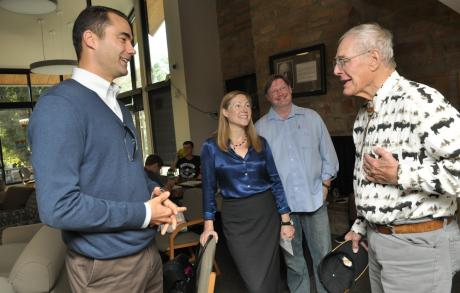ACADEMIA
Hansen hunts pirates with new supercomputer model
Imagine being tasked with finding a nondescript gray car being driven somewhere in the United States. And imagine that your primary tools for finding that car are a few aircraft and a handful of vehicles of your own.
That’s the challenge the U.S. Navy faces when trying to find a pirate skiff trolling the seas off the coast of Somalia, the western Indian Ocean, and the Arabian Sea—an area the size of the United States. How can the search be optimized?
A new weapon in the war against high-seas piracy is helping improve the odds. A team overseen by Jim Hansen (AeroEngr ’92, MS ’93) has created a supercomputer model that combines data on weather, ocean currents, commercial shipping information, available intelligence information, and known pirate behavior to identify the most probable areas for pirate attacks. By running many hundreds of thousands of scenarios, researchers can develop a picture of pirate behavior to give navy commanders an advantage on escalating piracy.
“We’re able to demonstrate that the environment has an impact on pirate activity,” says Hansen, lead scientist at the probabilistic prediction research office at the Naval Research Laboratory’s (NRL) Marine Meteorology Division in Monterey, California. He is also head of one of the branches of the Marine Meteorology Division at NRL.
Using predictive modeling techniques, the program can be updated numerous times a day as new forecasts of winds, wave heights, and undersea currents—which can affect the pirates’ ability to operate small boats in attacks on commercial ships—become available. But it isn’t enough to simply overlay this environmental data with behavioral and intelligence information. The program couples environmental, intelligence, and behavioral information in a dynamically consistent way.
Also armed with information about where pirates have their bases, where they like to hunt, and what kinds of boats they use, the model accounts for how environmental factors could impact their ability to maneuver. By running the model hundreds of thousands of times using slightly different attributes each time, multiple pirate tracks are interpreted probabilistically and disseminated to decision makers.
The result of the predictive modeling program is a color-coded map of the Indian Ocean showing areas of probability for a pirate attack, similar to the weather forecast maps compiled by the National Oceanic and Atmospheric Administration.
“There is a lot of richness in the information,” says Hansen, “and you can break it down in a lot of ways. The basic idea of simulating behaviors is not new, but what’s unique is the coupling with environmental information and the application to piracy. This product is consistent with how we think the pirates work. It gives us information about where they’re likely to be.”
The model can be used for additional applications. Hansen is applying similar ideas to the illicit trafficking problem and the anti-submarine warfare problem. In addition, Hansen uses environmental forecasts to plot optimal routes for navy ships to follow that minimize fuel consumption. He also is developing software that predicts likely distributions of hurricane winds and waves to provide guidance about whether ships should move away from naval bases that might be impacted by a storm and the optimum routes to take into open water.
Anyone planning a picnic or an outdoor wedding knows about the uncertainty of long-range weather predictions. Sometimes three-day and five-day weather forecasts are spot on and sometimes they miss the mark completely. Another of Hansen’s research interests is estimating uncertainty in a weather forecast and predicting how accurate their three- and five-day weather forecasts will be.
“I’m trying to find ways to give operational forecasters uncertainty guidance,” he says. “We run weather prediction models from around the world with small perturbations to the initial conditions to get 20 to 40 forecasts instead of just one forecast. That takes a lot of computer power.”
Thanks to chaos, when they make those small initial perturbations, what they end up with by day five is a collection of completely different weather forecasts, each one an equally likely representation of what the actual weather will be.
“Whether you’re talking about weather forecasting, ship routing, or pirate interdiction, perhaps just as important as estimating uncertainty is communicating all that information to a decision maker in a useful way,” he says. “That’s an important piece that’s often overlooked and it’s something I work on and worry about all the time.”
The son of an aeronautical engineer, Hansen grew up under the flight path of Sea-Tac Airport in Seattle, Washington. He remembers being four years old sitting on his front porch watching planes take off and land, and thinking that it would be fun to design airplanes some day.
While at CU-Boulder, Hansen was an All Big Eight tackle and the 1992–93 captain of the Buffs football team. He graduated from CU-Boulder with undergraduate and graduate degrees in aerospace engineering sciences. In 1998 he received a PhD in atmospheric, oceanic, and planetary physics as a Rhodes Scholar at Oxford University, and then he taught physics at Oxford’s Exeter College.
Prior to joining NRL, Hansen was an assistant professor of earth, atmospheric, and planetary sciences at the Massachusetts Institute of Technology.
“I greatly enjoyed doing basic research, but having a background as an engineer, I wanted to try my ideas out in a more practical setting,” says Hansen. “Unfortunately, I couldn’t do that in the academic environment. In my field, it is difficult to take a basic science idea and transition it from academia into an operational center to see if it actually works. I decided to leave academia and I’m very fortunate to be at NRL.”
Last fall, Hansen returned to CU-Boulder to give a talk about his work using predictive modeling techniques to combat pirate activity.
“I like to tell students that regardless of what you end up doing in life, engineering is a great background to have,” says Hansen.
Even for hunting pirates.


